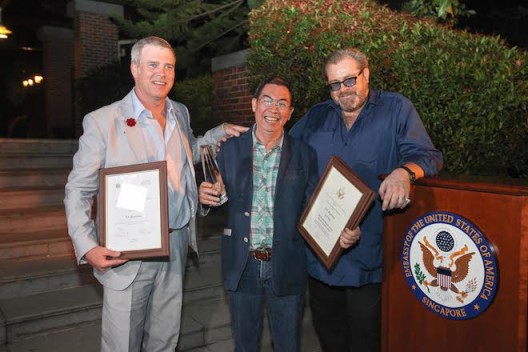The Indonesian artist FX Harsono has won the inaugural Joseph Balestier Award for the Freedom of Art, jointly presented by the Embassy of the United States in Singapore and Art Stage Singapore.
Over the course of Singapore’s recently concluded Art Week, word of the prize and its presenters bounced around the week’s unrelenting barrage of happenings, eliciting anything from convivial optimism to faint confusion, at times verging on outright skepticism. The questions the award seems to prompt are: “What is the United States Embassy doing teaming up with Art Stage to present an art award?” “Who is Joseph Balestier?” and “What does he have to do with freedom and art?”
With the fair being, at heart, a commercial enterprise, and the embassy being a government organ for the development of international relationships and the promotion of American interests, it is hard not to wonder about the extent to which the award serves these interests. It is a point which has clearly been anticipated: during Lorenzo Rudolf’s speech at the award ceremony, the fair’s founder related his absolute lack of surprise at being bombarded by similar questions. While acknowledging that the award could be perceived as having a political angle, he defended the award’s championing of the freedom of art and expression, saying, “These values are of principal and global importance—and have nothing to do with any regional political issue.”
That being said, the award still invites comparison to the CIA’s covert funding of the Congress for Cultural Freedom, best known—at least within the art world—for promoting Abstract Expressionism, as well as touring orchestras and jazz musicians, publications of intellectual criticism, and so on. And the Congress’s ultimate aim? Parrying Soviet Russia’s own soft-power thrusts, in particular the charge that the United States was a cultural wasteland.
While the Cold War may have ended long ago, a similar brand of cultural diplomacy continues to thrive in the open: where once “jazz diplomacy” was deployed as a counter to the Soviets [see here and here], now “hip-hop diplomacy” hopes to counter militant Islamic fundamentalism. One can hardly be faulted for harboring the suspicion that the Joseph Balestier Award, all protestations aside, might be more loaded than it seems. For one thing, not all of the ten ASEAN member states were represented in the nominations.
Perhaps that sense of unease does not stem from any hidden agenda in particular. Rather, it may be a sense of discomfiture at seeing yet another yawning crack in the romantic notion of an elevated, rarefied art that does not truck with the mundane politicking of the world. It is a notion that was occasioned by the decline of Renaissance-era systems of patronage, under which art served a much more explicit social function than it now does—an echo, in the Singaporean experience, of state demands for “nation-building” art.
It’s not an easy transition to encapsulate briefly, but in a 1974 essay, “Abstract Expressionism, Weapon of the Cold War,” the art historian Eva Cockcroft sums it up thus: “After the Industrial Revolution, with the decline of the academies, development of the gallery system, and rise of the museums, the role of artists became less clearly defined, and the objects artists fashioned increasingly became part of a general flow of commodities in a market economy . . . In rejecting the materialistic values of bourgeois society and indulging in the myth that they could exist entirely outside the dominant culture in bohemian enclaves, avant-garde artists generally refused to recognize or accept their role as producers of a cultural commodity.”
Instead of pre-modernity’s straightforwardly explicit contract, art’s social utilization now finds itself distributed across an interconnected web of institutions, employing approaches rather more subtle than the old “I’m supporting you, so make me and my buddies look good.” For instance, in the CIA’s covert interest in Abstract Expressionism, support could be routed through various channels to organize touring exhibitions, fund platforms for favorable critics, and ultimately canonize it in major institutions. Returning to the present day, within a prevailing climate of embedded, implicit utilization of art, it would hardly be fair to single out the Joseph Balestier Award for the Freedom of Art for having the potential to leverage art for political purposes—rather than some naïve view of innocent artists being preyed upon by the memetic warfare of powerful institutions, it might be more accurate to imagine, à la “House of Cards”, a tangled skein of Faustian bargains, albeit with fewer actual back-stabbings.
